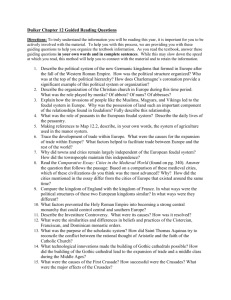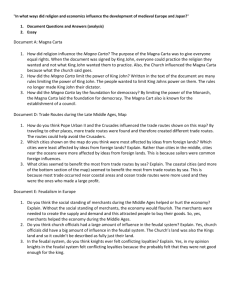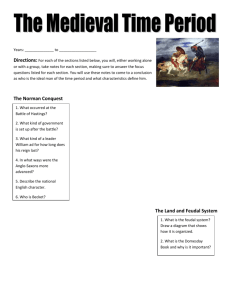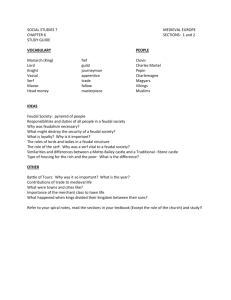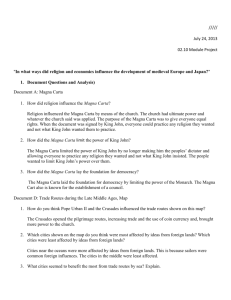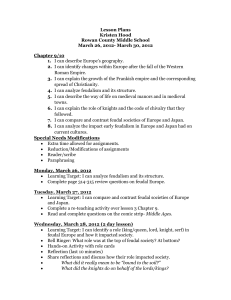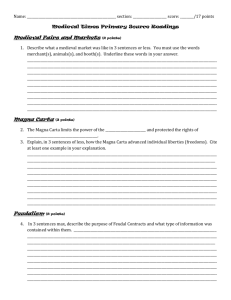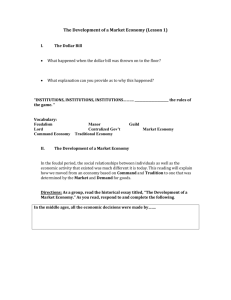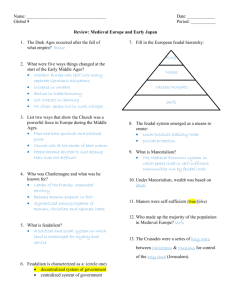02.10 Module Project
advertisement
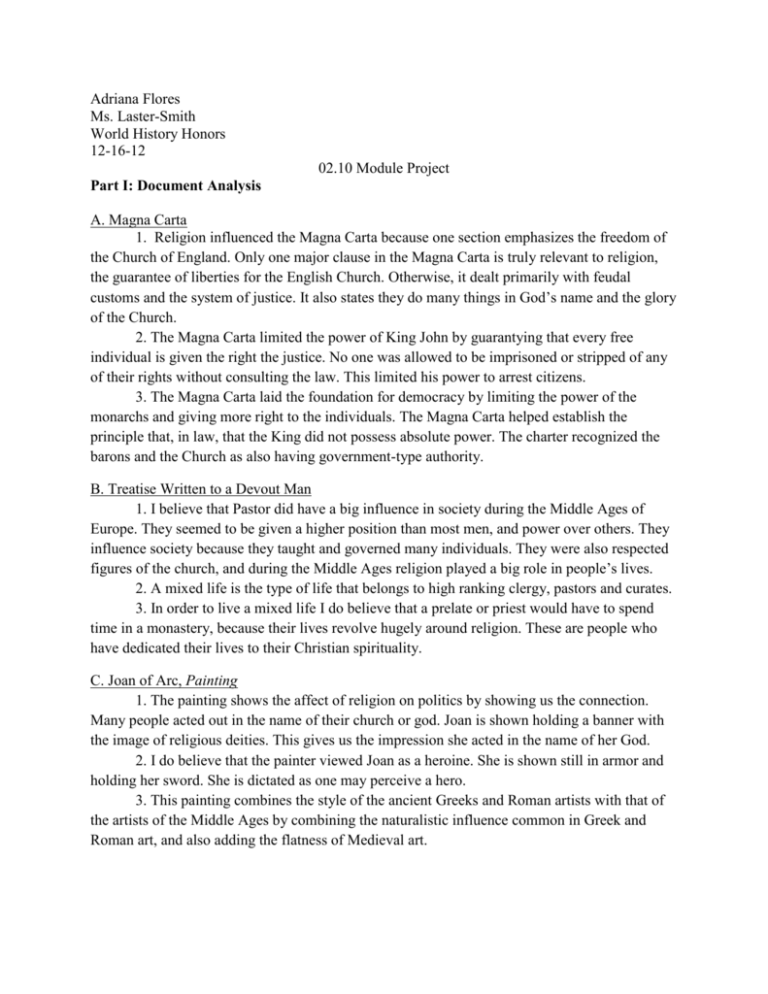
Adriana Flores Ms. Laster-Smith World History Honors 12-16-12 02.10 Module Project Part I: Document Analysis A. Magna Carta 1. Religion influenced the Magna Carta because one section emphasizes the freedom of the Church of England. Only one major clause in the Magna Carta is truly relevant to religion, the guarantee of liberties for the English Church. Otherwise, it dealt primarily with feudal customs and the system of justice. It also states they do many things in God’s name and the glory of the Church. 2. The Magna Carta limited the power of King John by guarantying that every free individual is given the right the justice. No one was allowed to be imprisoned or stripped of any of their rights without consulting the law. This limited his power to arrest citizens. 3. The Magna Carta laid the foundation for democracy by limiting the power of the monarchs and giving more right to the individuals. The Magna Carta helped establish the principle that, in law, that the King did not possess absolute power. The charter recognized the barons and the Church as also having government-type authority. B. Treatise Written to a Devout Man 1. I believe that Pastor did have a big influence in society during the Middle Ages of Europe. They seemed to be given a higher position than most men, and power over others. They influence society because they taught and governed many individuals. They were also respected figures of the church, and during the Middle Ages religion played a big role in people’s lives. 2. A mixed life is the type of life that belongs to high ranking clergy, pastors and curates. 3. In order to live a mixed life I do believe that a prelate or priest would have to spend time in a monastery, because their lives revolve hugely around religion. These are people who have dedicated their lives to their Christian spirituality. C. Joan of Arc, Painting 1. The painting shows the affect of religion on politics by showing us the connection. Many people acted out in the name of their church or god. Joan is shown holding a banner with the image of religious deities. This gives us the impression she acted in the name of her God. 2. I do believe that the painter viewed Joan as a heroine. She is shown still in armor and holding her sword. She is dictated as one may perceive a hero. 3. This painting combines the style of the ancient Greeks and Roman artists with that of the artists of the Middle Ages by combining the naturalistic influence common in Greek and Roman art, and also adding the flatness of Medieval art. D. Trade routes during the late Middle Ages, Map 1. I believe that Pope Urban II and the Crusades influenced the trade routes because even though the goals of the Crusades were not accomplished, they had a lasting effect on the European economy, trade routes were opened, new markets were established, and shipbuilding was improved. Relationships within Europe improved and trade prospered. 2. The cities that I believe were most affected by foreign lands were the ones near the coast, on the borders, and directly located on trade routes. These cities would have more contact with foreign cultures and people when they began trading, and therefore would be the one most affected. 3. The cities that would benefit most trade routes through the sea would be the one with coast side locations, or the ones that had fairly large ports. This way they could have more merchandise and goods delivered directly to the city and they could barter directly with traders. E. Feudalism in Europe, Graphic 1. I believe that the social standing of merchants hurt the economy. Merchants directly influenced the economy and played a huge part in markets. I believe they would’ve prospered more had merchants been given a higher social standing. 2. I believe that church officials had a large amount of influence in the feudal system. They were obviously high up when looking at their social standing. They were under only the monarch at the time. They were given a large amount of power and respect. 3. I believe at knights may have felt conflicting loyalties. Knights were often characterized as extremely loyal to their King and to their church. If the church and the monarch were to have disagreements, the knights would have a reason to feel conflicted. In the en dthey were expected to put their King before others. F. Feudalism in Japan, Graphic 1. I believe the social standing of merchants hurt the economy. Merchants are at the absolute bottom of the Japanese Feudal system. Merchants directly influenced the economy and played a huge part in markets. I believe they would’ve prospered more had merchants been given a higher social standing. 2. Feudalism in Japan and in Europe are very similar. They share many aspects the only thing different is that the in the European feudal system merchants were above peasants and artisans, while in the Japanese feudal system the peasants and artisans were above the merchants. 3. I do not believe that the feudal system helped unify the people of Japan. Far from it, it seem to separate the people of Japan. Your social standing determined whom you talked to. The nobles would more than likely never talk to the peasant or even the merchants. G. Articles of Admonition 1. I do believe Buddhism had a huge influence on in Japan. This excerpt allows us to see how they began incorporating aspects of Buddhism into their lives. The writer of this excerpt even directly compares his writings to the teachings of Buddhism. 2. I believe that in Medieval Japan what attributes most to moral behavior would be having respect for others and yourself. Its also shows that he believes you must thoroughly work hard in everything you do. 3. The negatives influences he believes his brother should avoid would be the influence of his peers or friends. H. Excerpt for Secondary Source and Topographical Map of Japan 1. Trade was instrumental in the spread of Buddhism throughout Japan because trade throughout the nation allowed people to come in contact with many different people, cultures and point of views. Cultures began to spread. 2. I believe that the geographical location of Japan, China and Korea did have a large affect on this trade. They were located so close to each other it was easier for them to trade with one another than to go into Europe and look to trade. 3. Trade from one area of Japan to another would be difficult because of the landscape of Japan is covered in mountain ranges and short rivers. These would be hard to travel over while carrying goods. Part II: Essay Though nations may be miles apart they may develop in a similar way. They are bound to be similar in some aspects. As humans we are all connected by the fact we share the ability of common sense and planning. At one point our thought process can be similar enough that we begin to develop similar perspectives and ideas. Japan and Medieval Europe show us this. They shared many similarities in their cultures and governments even though they never had contact with each other. Religious and economic influences impacted medieval Europe and Japan. They changed how their feudal systems developed, and the lives of the people in both nations. It also affected the trade of both nation. The feudal systems of both Medieval Europe and Medieval Japan were alike in many ways. They seemed to almost parallel each other. According to the Feudal System in Europe graphic and the Feudal System in Japan graphic both had similar structures. The monarch was at the top, followed by respected figures, followed by their warriors and finally at the bottom two levels you could find peasants, artisans, and merchants. Both of these Feudal systems were based on which social standard you were considered to be in and your economic position. The higher up in the Feudal system the better of you were, economically. These systems were a part of their lives. This shows us how economics impacted the development of the feudal system in both Nations. Religion affected the everyday lives of both nations. According to the Magna Carta, the people wanted freedom for the Church. It also shows us how many people acted out in the name of their god. We can see the huge role religion played in the lives of the people of Europe. Then in the Articles of Admonition we can see the importance that was placed on incorporating Buddhist morals and views into everyday lives of people. The author directly compares his own writing to the teaching of Buddhism. We can see how important Buddhism was in the lives of the Japanese. Religion influenced the people living in both nations. Their cultures are widely based on their religions and it affects how their nation develops. The trade in both countries was influenced heavily by both economics in religion. According to Trade routes during the late Middle Ages map, Europe’s trade was affected heavily by the crusades. The crusades were an attempt to spread Christianity. Thought they failed they allowed Europe’s trade to prospers. Furthermore, according to the Excerpt for Secondary Source and Topographical Map of Japan trade also helped Buddhism spread. While trade throughout Japan was difficult Buddhism spread throughout the nation through contact with it. In both nations their economies depended heavily on trade. It was this need for a prospering economy and attempt to spread religion that impacted both nation’s development and trade routes. All in all, religion and economic did have a huge influence on both medieval nations. A few examples of how they influenced both are that they impacted the development of the feudal systems of both nations, and they changed the everyday lives of the individuals. Furthermore, they impacted the trade routes throughout their countries. We can see this by analyzing primary sources available to us and we can also see it in the charts, maps and other graphics based on mush of the information found in these primary sources.
